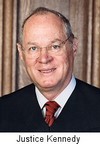 Justice Kennedy’s concurring opinion in eBay included a number of striking comments including the following:
Justice Kennedy’s concurring opinion in eBay included a number of striking comments including the following:
The potential vagueness and suspect validity of some of these patents may affect the calculus under the four-factor test.
If I understand them, the four justices are telling lower courts to reevaluate a patent’s validity and enforceability at the injunction stage — even after those issues have been decided in the patentee’s favor. If you remember, the question of an injunction only arises after the patent has been found valid, enforceable, and infringed.
Perhaps there are parallels between Kennedy’s position and the sentencing of a convicted criminal. At the sentencing stage, the sitting judge has a rather free hand to consider the evidence at hand in mitigating the prison time — even if the jury made opposite conclusions. Here, even if the jury found that the patent was valid and infringed, Kennedy would allow the court to deny an injunction based on the patent’s “suspect validity.”
Of course this approach is wrong, but if you are a cautious patent attorney the solution is simply to not write vague or questionable patent applications.
Links:
Dennis misses the point here and reveals another one. Not every patent infringement defense includes (or rather should include) a validity challenge (is the USPTO so incompetent that all patents are bogus?)but as we see, nearly every defendant throws up a validity defense regardless of how nonsensical it is. Dennis is assuming this to be the standard when writing that in every instance of a permanent injunction, the issue of validity has been adjudicated. It is a telling sign of the nature of patent litigation today and one which ought to be taken up on the side of the patent holder, as opposed to putting him invariably as a exploitive troll extorting money from the innocent infringer who (apparently) did all the hard work. Nonsense.
However, I agree with his view that allowing a judge to make his own, in effect, JMOL end-around is wrong.
Has anyone argued that this USSC decision is against prior precedent as decided in light of current events (e.g. the RIM case)?
Even if the patent has suspect validity or is vague, the defendant presumably would have its opportunity to argue that the claims were obvious, not novel, and indefinite in litigation. When balancing the hardships of the parties, the defendant’s hardships should be viewed in this light.
What will litigators think of Justice Kennedy’s comments applied to non-patent areas? For example, could a district judge, deciding whether to grant an injunction on a covenant-not-to-compete case, say “The potential vagueness and suspect validity of some of these contracts may affect the calculus under the four-factor test”? The case before the district judge should be decided on the facts of that case, not on the quality of other patents or other contracts. Otherwise, if I am a cautious patent attorney striving not to not write vague or questionable patent applications, the district judge is still assessing my work based on the vague or questionable work of other, perhaps less cautious patent attorneys.
Justice Kennedy’s comments may be aimed squarely at a RIM/NTP situation where the USPTO had announced an intention to cancel the patents and Judge Spencer said that what was happening at the USPTO was irrelevant to him. As a result RIM had to pay in excess of $600 Million dollars to avoid an injunction which would have been based on patents likely to be cancelled. Kennedy’s comments seem both reasonable and correct when seen in that context – the result in the RIM/NTP case on the other hand is an indictment of how patents are enforced.